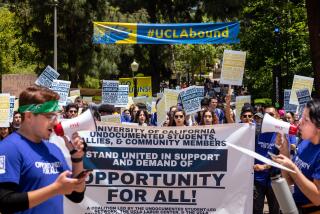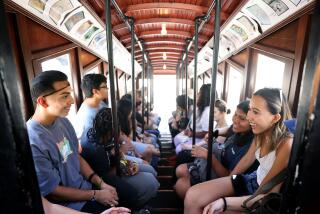Grad puts Central America on the map
The large wave of refugees from war-ravaged Central America that arrived two decades ago has transformed more than neighborhoods, the workforce and restaurant cuisine of Southern California.
Now, as Vanessa Guerreroâs new diploma shows, the influence of that migration is being embraced academically by one of the regionâs largest public universities.
At her recent midyear graduation from Cal State Northridge, Guerrero became the first student in the United States to earn a bachelorâs degree in Central American studies, officials say. Eight years after starting the nationâs first minor in the field, the school took another unprecedented step last fall by elevating it to a diploma-worthy major.
Like many of her classmates with family roots in Central America, Guerrero said she wanted her studies to help pierce the walls of silence that older generations built around memories of violence and economic turmoil in their homelands.
âA lot of our families donât talk about it very much, and if they do, we hear only one side of the story,â said Guerrero, 23, who was 5 when her family fled civil war in El Salvador. âI was definitely interested in learning more about my culture and my history.â
Some friends questioned the usefulness of Central American studies, an interdisciplinary program in history, sociology, literature, anthropology and the arts. But Guerrero, a North Hills resident who also majored in business administration, said the courses âhelped me understand the issues of why people migrated, why weâre here, why Iâm hereâ and would aid her plans to become an immigration or family law attorney.
Cal State Northridge has one of the largest groups of Central American students in the country, most of Salvadoran and Guatemalan descent. An estimated 3,500, or about 10% of the student body, were born in Central America or have immigrant parents who settled here, often near downtown Los Angeles or in the San Fernando Valley.
The university is known nationally as a pioneer in ethnic studies. Its Chicano and African American studies departments arose from late 1960s student protests, and the campus later added programs in Asian American, Armenian and Jewish studies. Supporters say ethnic studies are needed in a multicultural world, while critics contend that those classes foster racial identity instead of solid scholarship.
Central Americans constitute the vast majority of the 50 students enrolled in the new major and the several hundred others taking its courses. But some students had little previous contact with Central American cultures and âreally want to understand this community and work with it,â according to program coordinator Beatriz Cortez, who was born in El Salvador and is an expert in Central American literature and art.
The program offers 21 courses, including Survey of Central American Literature, Changing Roles of Central American Women and others about film, religion and revolutionary movements. It has three full-time professors plus six others who work part time or are from other campus departments.
âSome of us recognized a need for there to be a kind of academic discipline to both document and analyze the Central American experience, especially given the huge Central American population in places like Los Angeles, San Francisco and Washington,â said Roberto Lovato, who helped found the program and has taught in it.
At first, classes cobbled together readings from various sources because textbooks about Latino literature and history tend to concentrate on Mexicans, Puerto Ricans and Cubans. âWe are the new kids on the block, and we still have a long way to go,â said Lovato, a son of Salvadoran immigrants and now a writer in New York.
Larry Estrada, president of the National Assn. for Ethnic Studies, said that Central American classes are usually included in more general Latino programs and that Cal State Northridgeâs degree is the only one he knows of in the country.
âItâs a welcome addition,â said Estrada, a professor at Western Washington University. (Cal State established a Central American minor last year within its Latin American studies program.)
Northridgeâs Central American classes were initially part of Chicano studies. People involved say the split involved sentiments akin to Central Americansâ resentments about Mexican American dominance in Latino life in Los Angeles.
âCentral American studies was a new entity, and it deserved its own space,â recalled professor Rodolfo Acuna, founder of the universityâs Chicano studies department. âNo group wants to be eclipsed by another.â
The Central American program faced initial budget and planning problems, and its status will be reviewed in five years, when administrators expect to win permanent approval. But it seems to have escaped earlier ideological battles surrounding ethnic studies at schools nationwide, in part because it does not focus on one country or ethnicity. For example, UCLA students staged a two-week hunger strike in 1993 to gain departmental status for Chicano studies, a goal not reached until 2005.
The Cal State Northridge classes look at Central Americaâs seven nations -- Belize, Guatemala, El Salvador, Honduras, Nicaragua, Costa Rica and Panama -- and their complicated tapestry of cultures and languages. Next fall, the program will add a professor, an anthropologist who specializes in the Creole and African-derived cultures along the Caribbean coast.
At a recent class of Modern History of Central American Peoples, instructor Celia Simonds lectured to 30 students about the federation that included most of the now-separate nations in Central America from 1824 to 1839 and the tensions between liberals and conservatives over economic and religious issues.
Simonds also spoke of how the regionâs racial prejudices affected her own Costa Rican family. Her mother, a dark-skinned woman with some indigenous ancestry, was ridiculed by Simondsâ light-skinned paternal grandmother of Spanish heritage.
Another frequent theme is the political and emotional aftermath of the conflicts in El Salvador, Guatemala and Nicaragua. Douglas Carranza, an anthropologist who is director of the programâs affiliated research institute, said some studentsâ parents were afraid of opening old wounds. âIt is sometimes too painful to talk about,â he said.
But he stressed that student curiosity about family travails soon expands into many other topics, such as ancient history and environment.
Josue Guajan, for example, was born in Chicago and raised mainly in Guatemala until his family returned to the U.S. when he was 16. Through a Cal State Northridge class he realized, âI didnât know that much about Central America, even though I lived over there. That made me keep going and keep learning.â
Now 23 and a double major in television production and Central American studies, the Van Nuys resident wants to become a documentary filmmaker specializing in the region. He is a leader of the Central American United Student Assn., which has provided water-supply equipment to Salvadoran and Guatemalan villages.
Karen Romero, a U.S.-born daughter of Salvadorans, said she delayed graduation to take extra classes for a double degree in history and Central American studies. Now 25 and a resident of the Mid-City area of Los Angeles, she wants to teach history in high school or college and thinks her Northridge education will help her better relate to students in ethnically diverse classrooms.
Her mother, she said, was upset at first that Romero was studying Central American politics because it revived memories of friends murdered because of activism at Salvadoran universities in the 1970s. Now, Romero said, her mother is âvery proudâ and tells relatives her daughter âknows more about the history of Central America than we do.â
--
More to Read
Sign up for Essential California
The most important California stories and recommendations in your inbox every morning.
You may occasionally receive promotional content from the Los Angeles Times.











